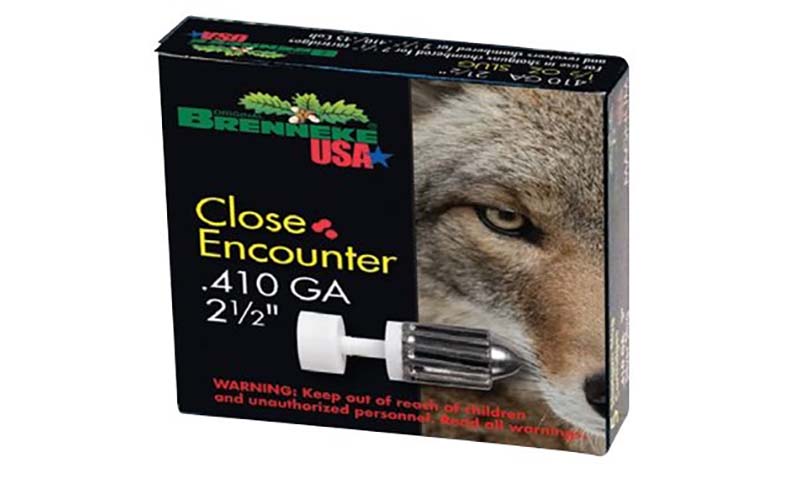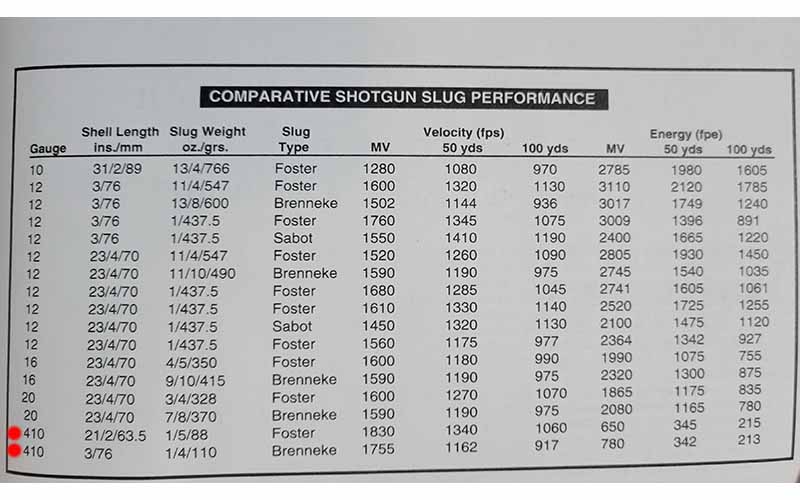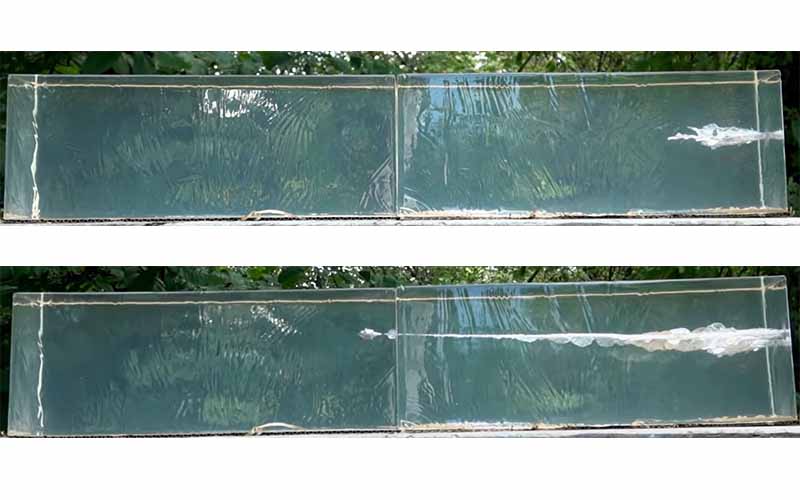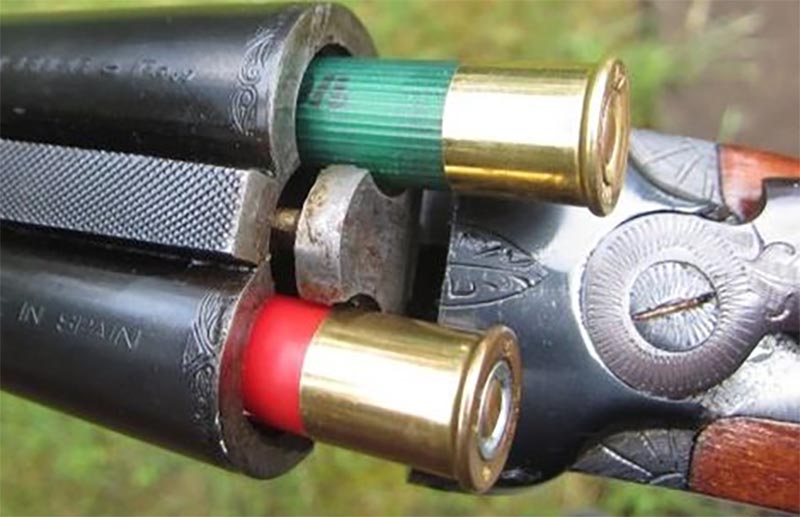
Inadequate for self-defense, .410 slugs’ primary use is for hunting, so what are the largest animals and the longest ranges they can be used for?
Having already discussed that any load of .410 is a suboptimal choice for defending against humans, it raises the question of what exactly this cartridge is good for. The answer is obviously hunting, but because .410 slugs are the most effective load type for this purpose the next logical question is what’s the largest sized animal that could be effectively hunted with a .410 slug? Let’s take look at their ballistic properties to find out.

.410 Slug Ballistics
If you’re considering hunting with a .410, before looking at its ballistic efficacy its important to check one’s local laws and regulations. Depending on where you are, .410 bore shotguns may or may not be legal to hunt with. Assuming that they are legal for you to use, what’s the biggest animal one could reasonably expect to hunt with a .410 slug? Part of this question pertains to how humanely the kill can be achieved as well, as one would not want to use ammunition that would only wound an animal and give it the chance to flee and succumb to its wounds later on. Good hunters know that both for the sake of efficiency and out of respect for the animal, one should always aim to harvest their game as swiftly as possible. The smaller the projectile used and the less energy it imparts on the target elevate the importance of shot placement. While a 12-gauge has enough energy to drop most deer even with an imperfect shot, .410 requires greater care to achieve the same result.

As this chart from Frank Barnes’ Cartridges Of The World shows, while .410 slugs exit the muzzle with velocities higher than most 12 or 20-gauge slugs, they lose that velocity at a faster rate than the larger mass projectiles do. The .410 slugs also deliver less foot-pounds of energy on target even at the muzzle, and again with a greater rate of loss as the range increases. What this data translates to is that while .410 slugs may provide sufficient energy within 50 yards, beyond that its efficacy begins to drop dramatically. In fact, according to some ballistician’s recommendation of a minimum 1,000 foot-pounds of energy to ethically kill a deer, the .410 is inadequate even at the muzzle. This doesn’t mean that ethical kills can’t be achieved with .410, even beyond 100 yards, but it does mean that one’s shot placement becomes massively more important in order to achieve it.
.410 Slug Selection
Not all slugs are created equal, and when it comes to .410 that seems to be doubly true. The two primary slug types one will find for a .410 (or any shotgun) are Foster and Brenneke. You can see on the previous chart that both kinds were tested, and the results show similar performance between the two save for the Foster’s slightly higher velocity and energy at most distances. This may lead you to believe that Fosters are the superior .410 slug, but results on soft targets paint a different story.

The main difference between the two kinds is that Brenneke slugs’ wads stay attached to the projectile throughout the slug’s travel. Where Foster slugs use their hollow base to create negative air pressure to stabilize themselves, Brenneke slugs use their wad to do so. It would take a better understanding of physics than I possess to explain exactly why this is the case, but the result of the slugs’ differences makes the Brenneke far more effective on target.

Perhaps due to the Foster slug’s higher velocity, the construction of the projectile or some combination of these two factors, Foster slugs typically disintegrate upon impact and provide very little penetration. While this may be adequate on smaller game, the importance of proper penetration depth on something like a deer is far more vital. To have the best chances of dropping a larger animal with a .410 slug, always choose a Brenneke over a Foster.
Should You Hunt Deer With .410 Slugs?
Firstly, a deer is probably the largest animal one should consider using a .410 to hunt with. Anything larger and the requirements for precise shot placement would become prohibitively difficult. People often recommend that the maximum range one should attempt to use a .410 slug to take a deer is 100 yards, but some even say only 40 or 50. It all boils down to shot placement. There are shooters out there with the skill to make a 100+ yard shot on a deer with a .410 and drop it, but it raises the question of why one would want to. If you’re seeking to challenge your marksmanship skills, it seems that it would be more ethical to practice that on a target that would not suffer as a result of your mistakes. If you insist on testing your marksmanship while hunting, however, a rifle will provide a more consistently accurate projectile that can reach out further than a shotgun slug ever could.
The lighter weight of .410 shotguns and their ammo combined with the cartridge’s lower recoil impulse make them appealing to the small-statured, the disabled and parents searching for their child’s first gun. If one of the traits of .410 appeals to you and you want to use one for deer hunting, there’s nothing wrong with that, but as Dirty Harry said, “a man’s gotta know his limitations.” In this case, one must know their own limitations of marksmanship as well as the limitations of their weapon. While on a hunt with a .410, spotting a deer should make you ask yourself “is it close enough for .410 to effectively drop it?”, and “is it close enough for me to reliably hit its vital organs?” If you have any doubt about either answer, you should probably think about trying to get closer. These are all considerations that are less important with 20 or 12-gauge, so unless one of the .410’s traits specifically benefit you, you’re likely better off sticking to one of the larger gauges.

So, do .410 slugs serve a purpose? They are absolutely viable for hunting, but the larger the animal and the greater the distance the less effective they become. For those considering using .410 slugs for deer, you should really have a valid excuse as to why you’re using that over 20-gauge at the least, and you must remain very cognizant of both your and your weapon’s limitations. For the average shooter, this probably means sticking within 50 yards for a deer-sized animal and placing extra care on one’s shot placement. While plenty of deer have been bagged using .410 in the past, in 2021 it only offers some niche advantages that most individuals would not benefit from. While .410 has gained some popularity with hunters in recent years, most people would still be better off with a 12 or 20-gauge.
More on Shotguns:
- The 5 Best Bullpup Shotgun Options
- The Beretta 1301 Tactical
- The Beretta A300 Ultima
- Top Four Remington 870 Options
- All About AK Shotguns

Next Step: Get your FREE Printable Target Pack
Enhance your shooting precision with our 62 MOA Targets, perfect for rifles and handguns. Crafted in collaboration with Storm Tactical for accuracy and versatility.
Subscribe to the Gun Digest email newsletter and get your downloadable target pack sent straight to your inbox. Stay updated with the latest firearms info in the industry.

![Best Concealed Carry Guns In 2025 [Field Tested] Wilson Combat EDC X9S 1](https://gundigest.com/wp-content/uploads/Wilson-Combat-EDC-X9S-1-324x160.jpg)


![Best 9mm Carbine: Affordable PCCs [Tested] Ruger Carbine Shooting](https://gundigest.com/wp-content/uploads/Ruger-Carbine-Shooting-100x70.jpg)
![Best AR-15: Top Options Available Today [Field Tested] Harrington and Richardson PSA XM177E2 feature](https://gundigest.com/wp-content/uploads/Harrington-and-Richardson-PSA-XM177E2-feature-100x70.jpg)

I disagree with the notion that the .410 slug is in adequate for home/personal defense within typical affected areas. A .410 slug fired from a 3″ magnum cartridge, is going to be effective against most human threats at reasonable ranges.
Inadequate for self-defense!? Is this part of a standup comedy routine, because I don’t see the punchline anywhere.
At least your opening saved me from wasting time on the article. Thanks.
Whois this author? It’s true anyone can claim to be an expert. .410 slugs would be devastating for self defense. 90 grains 1800 fps. Big old bullet. Forget buckshot.
The muzzle would look like a cannon. Much more instinctive accurate then pistols. But hearing protection inside, near walls.
“Inadequate for self-defense, .410 slugs” ???
100% UNSUPPORTABLE, from all tests.
And, superior under most considerations.
And? Shoot your ridiculously overpowered HD 12Gauge- INDOORS-,
and see!
Explain to me how a .410 slug is useless for defense when it delivers greater muzzle energy than a (539 ft-lbf) .357 Magnum? 780 ft-lbf of muzzle energy, in a wadcutter-shaped .41 caliber projectile that weighs 110 grains and has 31% more frontal area to form a wound channel doesn’t sound like “useless” to me, or to anyone else who thinks about it for a moment.
Given that it’s being fired from a long gun that’s both easier to point, and thus presumably easier to hit a target with, with lower recoil than a handgun, I’d say that it’s probably IDEAL for defense – when wielded by someone of smaller stature who doesn’t spend weekends at a range blowing the beer money on ammunition to keep proficient with a handgun.
For home defense I think the 410 shines rather well. my living room is not 100 yards. i dont know where this author gets his ideas. light recoil and messy holes. even the chart he lists shows the 410 doing well at 50 and 100 yards. 410 ammo
I have .410 3″ magnums in “the Judge” in the drawer beside my bed for any animals that want to come into my house uninvited. That’s 5 shells with five 00 buck pellets each (twenty-five .33 caliber pellets in all.) With an effective range of 3-10 yards, and the bonus of low wall penetration (I live in an apartment building) makes .410 the perfect self defense weapon, in my opinion. And if 25 chunks of lead doesn’t do the job, the revolver is heavy and will make an effective club.
Shot placement and fpe are the most important thing to consider. However, 22 rifles have taken many deer and are legal from what I understand in some states. High powered air rifles lately have been approved in quite a few states and one chart shows that 150 fpe is all that is necessary for small deer of course at close range. Air guns for deer have taken deer with about 250 fpe which is more than most crossbows. Distance, power, shot placement are all important. Newer air rifles can reach up to 1500fpe which is more than many firearms. Experienced competent hunters can ethically take deer with lower powered weapons provided they can take an ethical shot. So absolutely a 410 in the right hands is good for deer.
Shot placement and fpe are the most important thing to consider. However, 22 rifles have taken many deer and are legal from what I understand in some states. High powered air rifles lately have been approved in quite a few states and one chart shows that 150 fpe is all that is necessary for small deer of course at close range. Air guns for deer have taken deer with about 250 fpe which is more than most crossbows. Distance, power, shot placement are all important. Newer air rifles can reach up to 1500fpe which is more than many firearms. Experienced competent hunters can ethically take deer with lower powered weapons provided they can take an ethical shot.
I concur 101% with all you stated…. > As a professional Hunting & fishing guide for over 4 decades .. I Have Used and seen Every Type Of North American (Canadian ) Big game animal – Shot at; wounded or Dropped Dead; with Every caliber Rifle; Arrow; or slug. “Shot Placement” is Always KEY; Knowing Your SHOOTING Weapon.. You Can Miss with Any of them; wound with any of them; OR; KILL..
I pay little attention to any and all Authors that POO POO any specific caliber and such.. I personally ( Now Retired ) use My single shot .410 Shotgun ( Slugs) for EVRYTHING ” Big Game ” That is legal from My Tree stands.. BEAR mostly; deer elk and Moose have all been Dropped..at 35-40 yds . Seldom have any further shots In the Bush anyway ..I have dialed in to being a one shot; Head shot over the years.. I Shoot a SHILTLOAD prior to seasons. ( Load My Own ).. and If I Get a shot In; at all; in season Its animal Down.. I have had no need to track; any wounded critter; Since I retired.. ( Hated seeing wounded Critters Still alive half a Day after being Shot with a Cannon & all the extra work !..) If It Not A sure Shot; I Do NOT “Shoot and Hope”… Shot Placement; knowing your weapon; its capabilities. and limitations; easier on YOU and the Critters .. .410 is a FINE weapon… 😉
While I agree that anything can kill with the right shot placement, crossbow killing (and any other bow) has nothing to do with energy. They kill by cutting and bleeding. Period.
Here in small town WV, WE don’t have to “hunt” deer, THEY hunt US! See ’em every DAY. They come in our yards and eat our gardens – which is actually why you are allowed to hunt them at all. The average shot being 2-8 yards, my Snake Sayer IV Derringer(!), with the Winchester “Predator”round (3-5pp #000 BUCK!) is plenty, for an instant kill (4-1/2″d. THROUGH wound.). And ? no license needed, to eliminate nuisance predators in your yard (town’s “no gunfire” ordinance? Written as WAIVED for this specific -but common- situation!). And I’m a Senior/Vet, so no license needed, anywhere in WV.
The POINT? Situations vary greatly.
Ironically, the author is making a good argument against the use of a bow and arrow, if you take his argument of the ethics of shooting at deer with a .410 seriously. I saw a person I will not identify hit a deer with 70lb draw weight bow at about 70 yards, hit it clean in the chest , and we lost the blood trail a mile later. God only knows where that poor beast ended up.
I live in a shotgun only area, no centerfire rifles allowed, I have hunted deer for 40yrs with a H&R 410 single shot using slugs, the brenneke are the best. I have made clean one shot kills as far out as 70yds, no deer has ever went farther than 30ft after being shot. I also must note that the brenneke slugs tend to pass clean thru time and time again.
Curious as to why the .410 is determined to be inadequate for self defense? Who makes that decision? I have a S&W Governor (6 round revolver) that accepts .410 shells. I would think this round would pack plenty of stopping power. Don’t most self defense scenarios take place at short range?
for home defense I think the 410 shines rather well. my living room is not 100 yards. i dont know where this author gets his ideas. light recoil and messy holes. and even the chart he lists shows the 410 doing well at 50 and 100 yards.
What in hell gives anyone the right to make light of others choices. Pretty anti freedom.
The First Amendment does, so pretty ironic of you to bring up freedom.
I don’t know, a 110 gr. 357 bullet traveling at something less than 1700 fps muzzle velocity is considered a one-shot manstopper. So how come a .41 caliber bullet traveling faster than the 110 gr. .357 is considered inadequate for defense? Any volunteers to stand in front of me at bad breath distance and let me peck away with the inadequate .410 Brenneke slug? What? I don’t see any volunteers. Hmmm. Sure the 600 grain Brenneke at 200 fps slower is going to make a bigger impression but the 4’10” 90# woman likely is liable to score more hits with the .410 than the 12 gauge. A 500 nitro express that misses the target is less effective than a .22LR that scores multiple hits in the head and/or pelvis.
Is the .357 Magnum a one shot man stopper at 50 or 100 yards. Unlikely. Those are the distances the author is talking about and he’s also referencing an ethical shot on a deer not a legally dicey fairly long shot on a human. Bad breath distance? Yeah, that’s not at all what we’re talking about here. Maybe it’s a good idea for you to reread the article as it seems you missed most of what the author wrote.
Well said.
Not my first choice, but any gun is better than no gun, I grew up using a .410, and put many squirrel, rabbit , dove, and a few deer, never shot anything I didn’t kill retrieve and eat. It’s like all guns , one should know the limits of the firearm in use.
The .410 is severely underrated for deer hunting and we have numerous youth that have killed many a nice buck with the lowly shotgun! It’s a shooter friendly gun that is very light and functional providing lifetime rewards and value.
The author said the .410 slug isn’t viable for self defense. I have seen the results of a Brenekee .410 slug fired at about 30 yards and I won’t be one to volunteer to be shot with it. You are right, many deer have been taken with a .410.
Inadequate for self-defense— My thoughts exactly.
Obviously you have never personally used this on a man sized animal (while hunting) and seen the effects . . . and it seems like neither has this “author” . . .